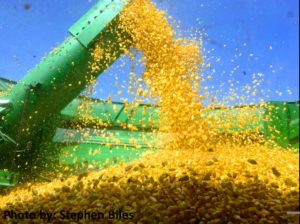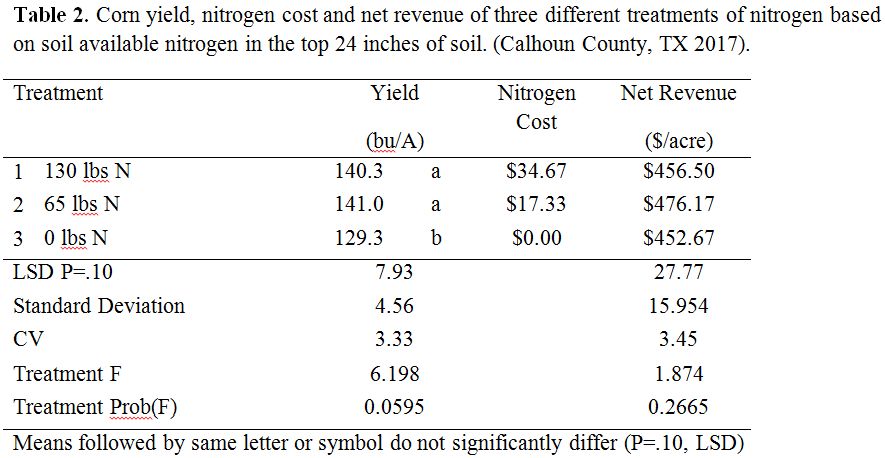 Two trials were conducted in 2017 the objective to evaluate the effect of reducing by the amount of residual nitrogen found in soil tests at depths up to 24 inches. Each of these trials were conducted with large plots in grower fields. What follows is the research report for the Corn test. (printable version)
Two trials were conducted in 2017 the objective to evaluate the effect of reducing by the amount of residual nitrogen found in soil tests at depths up to 24 inches. Each of these trials were conducted with large plots in grower fields. What follows is the research report for the Corn test. (printable version)
Evaluation of Reducing Nitrogen Fertilizer Application by Residual Soil Nitrogen Found to Depths Of 24 Inches in Corn
Investigator: Stephen Biles and Geri Kline
Cooperator: Clay Brett
Summary
A field research trial was conducted to evaluate the effect of using soil sampling to twenty-four inches to reduce nitrogen fertilizer application. Nitrogen fertilizer was applied to treatments of 130, 65, and 0 lbs N per acre in a replicated field trial. Grain yield of the 130 lbs N and 65 lbs N treatments were 11 and 11.7 bushels greater than the 0 N plots. Thought not statistically significant, the middle N rage provided a numerical advantage of $23.40 in increased profits over the 0 lbs N treatment and saved the grower $20 by cutting the fertilizer application in half.
Objective
Research conducted over the past decade has demonstrated nitrogen fertilizer applications can be reduced by the amount of residual nitrogen found in soil tests at depths up to 24 inches. This research was conducted to evaluate this concept on large scale plots in a grower field.
Materials and Methods
A field was sampled for soil nutrients in early January using a hydraulic soil probe to 24 inches. Soil testing was conducted at the Texas A&M Soil, Water, and Forage Testing Laboratory in College Station Texas. Results of the soil testing found 26 lbs N at 0-6 inches and 94 lbs N (15.65 ppm) from 6-24 inches for a total of 120 lbs residual N per acre (Table 1).
The corn hybrid Croplan 8410 VT3P was planted on March 3, 2017 along with an at-planting application of 70 lbs 11-37-0 fertilizer (7.7 lbs N/A) across all fertility treatments.
Post-emergence nitrogen fertilizer treatments were applied side-dress at the treatment rates of 0, 65, and 130 lbs/A on March 24, 2017. The fertility treatments were determined as follows:
- Treatment 1: Grower rate of fertilizer if no nitrogen was found (130 lbs N/A)
- Treatment 2: Grower rate of fertilizer less 50% nitrogen found to a 24-inch depth (65 lbs N/A)
- Treatment 3: Grower rate of fertilizer less 100% nitrogen found to a 24-inch depth (0 lbs N/A)
Plot size was 12 rows (38-inch width) wide and 2600 feet in length. Treatments were replicated three times in the field in a randomized complete block design. Eight of the 12 rows of each plot were harvested on July 31, 2017. Yield was measured with the combine yield monitor and reported as different fields in Climate Fieldview.
Results and Discussion
Yield was the only data point measured across all three replications. The yield of the 130 lbs N and 65 lbs N treatments were 11 and 11.7 bushels greater than the 0 N plots (Table 2).
Grower profit from these treatments was determined by assuming nitrogen fertilizer cost of $0.27 per lb N and corn value of $3.50/bu. Though not statistically significant, the middle N rate provided a numerical advantage of $23.40 in increased profits over the 0 lbs N treatment and saved the grower $20 by cutting the fertilizer application in half. The high rate of N application made only $3.40 net revenue over the 0 lbs N treatment. If application costs for the equipment and operator are included ($3-5 per acre), the 130 lbs treatment did not result in an increase in net revenue.
Acknowledgements
Thanks to Clay Brett for providing the location and materials for this research project.

